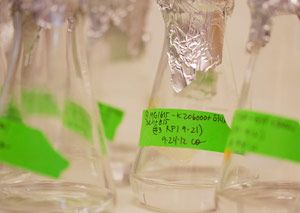Team:UC Davis/Project/Directed Evolution
From 2012.igem.org
(Difference between revisions)
| Line 1,255: | Line 1,255: | ||
The Tecan experiments with MG1655 and DH5a show us that the ethylene glycol does not hinder the growth and development of the strains, as long as it is mixed with LB media. The growth curves all had the same shape, independent of the amount of ethylene glycol in solution. We chose a broad, nearly exponential range of ethylene glycol concentrations to allow a broad range to test the toxicity. We attempted to find the lower limit of toxicity due to a saturation of ethylene glycol. However, we had not reached it. In our engineered strain, we will not expect to see a concentration of ethylene glycol above 150mM, so we can expect our strain to be able to live in an environment with a concentration as high as that. | The Tecan experiments with MG1655 and DH5a show us that the ethylene glycol does not hinder the growth and development of the strains, as long as it is mixed with LB media. The growth curves all had the same shape, independent of the amount of ethylene glycol in solution. We chose a broad, nearly exponential range of ethylene glycol concentrations to allow a broad range to test the toxicity. We attempted to find the lower limit of toxicity due to a saturation of ethylene glycol. However, we had not reached it. In our engineered strain, we will not expect to see a concentration of ethylene glycol above 150mM, so we can expect our strain to be able to live in an environment with a concentration as high as that. | ||
<br><br> | <br><br> | ||
| + | <center> | ||
| + | <img src="http://img.photobucket.com/albums/v26/bluemelon/photo1_1.jpg" align="left"> | ||
| + | <img src="http://img.photobucket.com/albums/v26/bluemelon/photo_2_1.jpg" align="right"> | ||
| + | </center> | ||
| + | <br><br><br><br><br><br><br><br><br><br><br><br> | ||
After seeing that ethylene glycol does not pose a threat to MG1655 and DH5a, we subjected the Barcelona strain to the same broad range of ethylene glycol. We sought out to find the most efficient concentration of ethylene glycol for this strain, as a guideline for the efficient concentration of EG for our engineered strain. While analyzing the data, we realized that we have to define efficiency more clearly. Efficiency can mean faster growth on low amounts of ethylene glycol or it could mean a higher optical density after a certain amount of time, where it reaches the stationary phase. We saw that once the ethylene glycol concentration reaches a certain threshold (49.34 mM), the growth curves are all the same in terms of time when the stationary phase has been reached. We saw that some of the E. coli were efficient at low concentrations, making us focus on the fast growth efficiency at lower concentrations of EG because the LC-cutinase will not degrade quickly enough to produce 49.34 mM in a cell’s solution. Now, we have an ongoing experiment where we re-passage cells between ethylene glycol media at 30 mM. We discuss this in more detail in our directed evolution section. | After seeing that ethylene glycol does not pose a threat to MG1655 and DH5a, we subjected the Barcelona strain to the same broad range of ethylene glycol. We sought out to find the most efficient concentration of ethylene glycol for this strain, as a guideline for the efficient concentration of EG for our engineered strain. While analyzing the data, we realized that we have to define efficiency more clearly. Efficiency can mean faster growth on low amounts of ethylene glycol or it could mean a higher optical density after a certain amount of time, where it reaches the stationary phase. We saw that once the ethylene glycol concentration reaches a certain threshold (49.34 mM), the growth curves are all the same in terms of time when the stationary phase has been reached. We saw that some of the E. coli were efficient at low concentrations, making us focus on the fast growth efficiency at lower concentrations of EG because the LC-cutinase will not degrade quickly enough to produce 49.34 mM in a cell’s solution. Now, we have an ongoing experiment where we re-passage cells between ethylene glycol media at 30 mM. We discuss this in more detail in our directed evolution section. | ||
</article></div> | </article></div> | ||
Revision as of 05:36, 29 September 2012

Directed Evolution
History
Genome Sequencing
Tecan Experiments


After seeing that ethylene glycol does not pose a threat to MG1655 and DH5a, we subjected the Barcelona strain to the same broad range of ethylene glycol. We sought out to find the most efficient concentration of ethylene glycol for this strain, as a guideline for the efficient concentration of EG for our engineered strain. While analyzing the data, we realized that we have to define efficiency more clearly. Efficiency can mean faster growth on low amounts of ethylene glycol or it could mean a higher optical density after a certain amount of time, where it reaches the stationary phase. We saw that once the ethylene glycol concentration reaches a certain threshold (49.34 mM), the growth curves are all the same in terms of time when the stationary phase has been reached. We saw that some of the E. coli were efficient at low concentrations, making us focus on the fast growth efficiency at lower concentrations of EG because the LC-cutinase will not degrade quickly enough to produce 49.34 mM in a cell’s solution. Now, we have an ongoing experiment where we re-passage cells between ethylene glycol media at 30 mM. We discuss this in more detail in our directed evolution section.
References
2. Andrianantoandro, Ernesto, Subhayu Basu, David K. Karig, and Ron Weiss. "Synthetic biology: new engineering rules for an emerging discipline." Nature - Molecular Systems Biology. (2006): n. page. Web. 29 Aug. 2012.
 "
"















